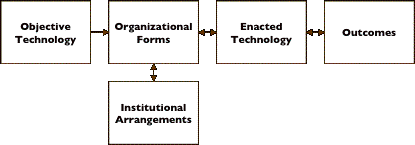
For many years we have been making a similar distinction: between Technology-as-Designed and Technology-in-Use. (Our concept of Technology-in-Use is broadly the same as Fountain’s concept of Enacted Technology, but we are uneasy with her characterization of Objective Technology.)
As technology change management practitioners, we can make the following observations.
Firstly, there is a many-to-many relationship between Designed Technology and Enacted Technology. Not only can the same Designed Technology be enacted in many different ways (even within the same organization), but the enacting process can sometimes nullify design differences. (In other words, technological features which designers think highly significant can often prove irrelevant in the context of use.)
The procurement process often focuses on the Designed Technology, or the so-called Objective Technology, although there may be some attention on how the technology has been enacted elsewhere. This means that the procurement process often fails to make good connections to the desired/expected outcomes, while often spending lots of time on technical features with minor impact on outcomes.
Secondly, there may be loose co-evolution between the Designed Technology and the Enacted Technology, but without tight synchronization. Sometimes new features are added to the Design that only slowly filter into practice; sometimes new practices emerge in the Enacted Technology and only get reflected in the Design after some delay.
Thirdly, the gap between Designed Technology and Enacted Technology is itself a subject of interest, and can reveal something about the maturity of both the technology and the organization.




No comments:
Post a Comment